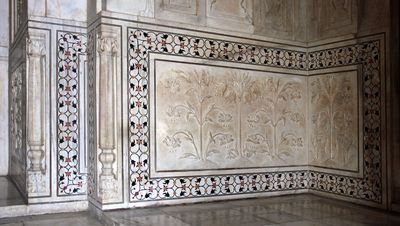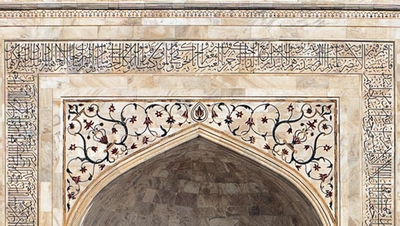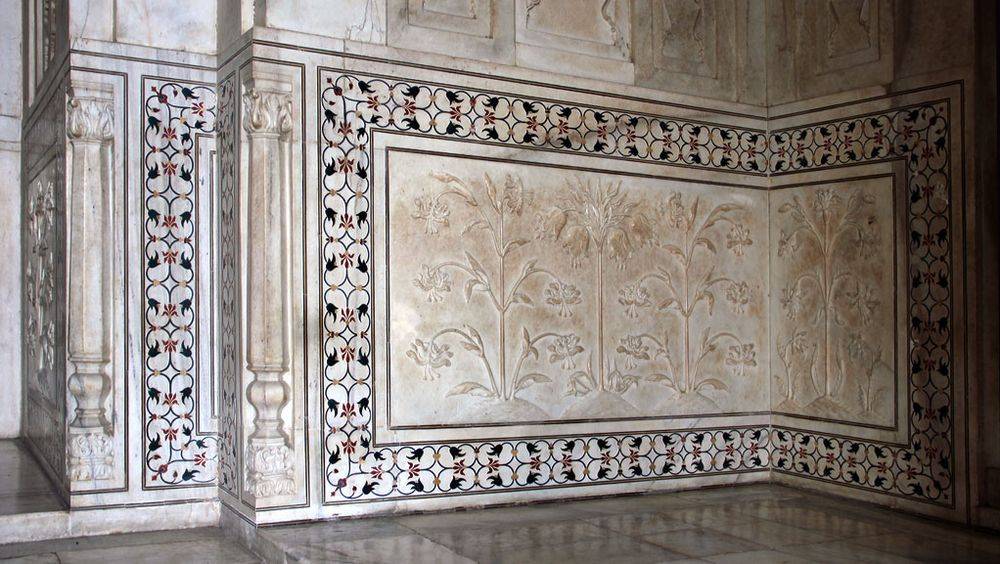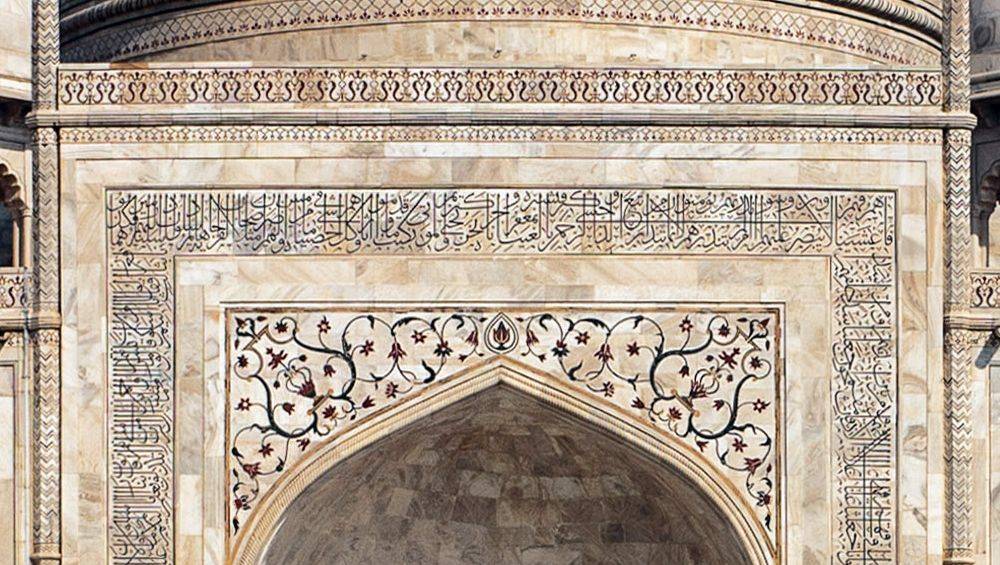As you can imagine, the Taj Mahal required a lot of people for its manufacture. The specialists of each profession were called to work on a site that brings together the peak of its activities up to 20,000 people. It was started in 1631. 17 years later, in 1648, the mausoleum hand was completed. The complete site was completed in 1653, 5 years later, the years that were used to build the enclosure, the ancillary buildings, and especially the gardens.
The style
The architecture of the Taj Mahal is clearly Indo-Islamic. It is a style combining Hindu art, traditional in this territory, and Islamic, this religion has been conveyed so far. The mixture of the two allowed a reinterpretation of the many Hindu traditions in an Islamic form that dominated the region since the time of the Delhi Sultanate (1192 - 1451). Subsequently the Mughal Empire took over and Indo-Islamic art took various forms depending on the political climate of the time. Thus with the first emperor Bâbur this style was little used, while under Akbar, it was greatly. The territory, historically populated by non-Muslims, delivered a workforce that was not used to Islamic style. However, it was under the direction of Muslim artists that they were built, hence these intertwined vegetation, this work of lapidary marquetry and the dome of lotus which is the flagship of Taj Mahal, synthesis of Islamic art and Hindu.
Craftsmen
Unfortunately, it is difficult to know who built the Taj Mahal. At that time, the name of the initiator of the project, Shah Jahan, was more to be remembered than to the workers, or even architects. It is a complete team of architects who designed and then directed the work of the monument, but their names are not really known. Only the names of 40 skilled workers are known. They are draughtsmen, masons, stonemasons, sculptors, marketers, dome builders, calligraphers, carpenters and designers of gardens. This list has come down to us from Persian sources.
If most craftsmen are unknown to us, but depending on the trade we know their origins, from a general point of view. Thus we know that the sculptors were more of Bukhara, the calligraphers of Syria and Persia, the workmen making inlays of southern India, the stone cutters of Baluchistan, and so on. Other regions were widely represented: Rajasthan, Malwa, Gujarat and Punjab, for example.
As for the workers, they were up to 20,000 on the site. Most of them were recruited from North India.
Here are some names that are still known:
- Ustad Ahmad Lahori : Main architecte
- Ismail Afandi, Ottoman Empire: Designer of the Main Dome
- Ustad Isa and Isa Muhammad Effendi, from Persia: Architectural Designer
- 'Puru' from Benarus, Persia: Supervisor Architect
- Qazim Khan, Lahore: Gilding
- Chiranjilal, Delhi: Chief Sculptor and Mosaicist
- Amanat Khan of Shiraz, Iran: Chief Calligrapher
- Muhammad Hanif: Mason Supervisor
- Mir Abdul Karim Khan and Mukkarimat of Shiraz: Financial Manager, Daily Production
Also, for comparison, we know that Babur employed 1491 skilled stonemasons on the construction of its buildings at Agra, Fatehpur Sikri, Bayana, Dholpur and Gwalior and 680 on the Agra buildings alone, which, compared to the Taj Mahal, were very minor works.
Thus the Persian lists show us that a certain Ata Muhammad, blood-tarash (stonemason) of Bukhara, worked on the Taj Mahal. He was paid 500 Rupees a month. Shakir Muhammad, Gul-tarash (a sculptor) from Bukhara also, was paid only Rs. 400, while Muhammad Sajjad, a Merfiar (Mason) from Multan, and Chiranjilal, a pachchikar (facadier) from Lahore, were paid 590 and 800 Rupees a month respectively. But these simple names pose a problem. Indeed, we see that stonemasons came Bukhara, and this city, small and little known, was not especially famous for its stonemasons. But India is a specialist in lapidary works, the art of stone is widespread and stonecutters are legion on the spot. Moreover, even in the time of Tamerlane, two centuries earlier, Indian laborers were called upon to work in other regions, particularly in Samarkand (to build a large mosque). So why bring stonemasons elsewhere? And above all, why have they paid so dear, knowing that the equivalent of the time of the Rupee would nowadays correspond to several months' wages of a worker?
The answer probably lies in the fact that this money did not go directly into the artisan's pocket. In fact, the craftsman was - probably - only a team leader, or a guild leader, and they were hired to do a job impossible to do alone. So they surrounded themselves with workers whose salaries they had to pay. These people were probably not even craftsmen but rather entrepreneurs making workers work. Moreover, what was paid to these people was a contractual sum, monthly, corresponding to the execution of a certain work. It does not matter if this work is done by a person or 10, the contract was frozen. This mode of operation is an invention of Mir-Imarat, coordinator of the construction, and it is thanks to that that we know some names of workers on the site while masking the name of the real workers of the site.
On this principle, the guild leaders were, for the Naqshanawi department (draughtsmen) Ustad 'Isa Afan di who had come from Shiraz. He received Rs.1000 per month for the men who worked under him. 'Abdul Haq, named Amanat Khan Shirazi, himself an expert artist, led the calligraphers department. Ran Mal was the draftsman of the gardens, he came from Kashmir. Pira was a master carpenter from Delhi, when the builders of the dome, they worked under the responsibility of Ismail Khan Rumi.
Qadir Zaman Khan was mentioned as dar-har-ek-phan-ustad-e-kamil, ie an expert in construction techniques which consisted of digging and filling the foundations, masonry, stone laying, lifting large weight blocks by ropes and pulleys, handling levels, maintaining drainage and dozens of other techniques in addition. Mir-Imarat, he was in charge of the entire construction of the Taj Mahal, he realized the purchase and storage of materials, the recruitment craftsmen and workers and disbursement of wages. He also coordinated all the work.
Origin of materials
Contrary to popular belief, the Taj Mahal's mausoleum is not made of marble, it is only covered. Indeed, the walls of the monument are red brick, made on site for obvious reasons of transport. It seems that these bricks have also been used for scaffolding, but it is not certain because at the time we used a lot of bamboo or even wood, to make these scaffolding.
The huge white marbles were made in Makrana, southwest of Jaipur, about four hundred kilometers away. To transport them the stonecutters had to rent trolleys whose expenses were charged to the royal treasury. The logs were cut with great precision, without any cracks.
The builders used different types of marble, which came from different regions and countries: Rajasthan, Punjab, China, Tibet, Afghanistan, Sri Lanka, and even the Arabian Peninsula were stone exporting centers.
Three types of stones were used in the construction of the Taj Mahal, they are indicated below by their local names.
The construction of the Taj Mahal involved the use of semi-precious stones such as Aqiq, Yemenite, Firoza, Lajward, Moonga, Sulaimani, Lahsania, Tamra, Yashab and Pitunia which were used for incrustations; rare and unusual stones such as Tilai, Pai-Zahar, Ajuba, Shelter, Khattu, Nakhod and Maknatis which were used in marquetry, for the famous pietra dura, for floors, and turrets and common stones Sang-i-Gwaliori (by will, gray and yellow).
Sang-i-Surkh (red sandstone), Sang-i-Musa (black marble) and Sang-i-Rukham (white marble) were used for foundations and masonry and as exterior facades. The red wish comes from Fatehpur Sikri, nearby, from Tantpur and Paharpur. White marble was purchased in Makrana, Rajasthan and was paid for, as shown in the three contracts exhibited in the museum's . Semi-precious and rare stones have been brought from distant places such as Tibet, Kumaon, Jaisalmer, Cambay and Ceylon. The Persian lists give precise numbers as well as the names of the stones. For example :
| Aqiq | 340 |
| Lajward | 240 |
| Moonga | 147 |
| Sulaimani | 559 |
| Lahsunia | 52 |
| Tamra | 398 |
| Ajuba | 850 |
| Yashab | 54 |
| Pitunia | 542 |
| Maknatis | 77 |
Of course these numbers do not indicate the number of actual stones used in total, in fact there were many more. These figures designate a "Phari" or "Dheri", each Phari corresponding to a cubic Zira. We call it a "reservoir" for the case of precious stones. Each figure is including a gemstone ability. If you still do not have an idea of what this represents, know that a zira is a measure of length in the Muslim world, it corresponds to a cubit in the European world of the time. If it is not very precise, we imagine that it is approximately 50cm, so a cubic zira is about 0.125m 2, or 125 liters. and there are hundreds!
These lists also provide a theoretical qualitative table used by the purchasing department to maintain a good level of quality.
As regards the manufacture of bricks, for the framework of masonry buildings, it should be known that they were manufactured locally and treated chemically to increase their strengths and stability. Ingredients such as molasses, batashe, belgiri water, jute and kankar have been mixed with lime mortar to make it the most perfect cementing agent possible.
The location
The Taj Mahal had to be on the edge of the Yamunâ for several reasons. First of all, water is one of the 4 rivers of Paradise according to the Koran, so it is logical that a tomb is near a river. Then the Yamuna, which crosses Agrâ, is a tributary of the Ganges, the purifying river of the Hindu religion, so by placing the deceased here, her soul will naturally be purified for the Hindu people on whom reigned Shah Jahan. Finally this area of the city, in the East, was the place where, in the seventeenth century, all the gardens and palaces of the notables Mughals, it was It was therefore quite logical that the Empress's grave should be here.
Initially the land on which the Taj Mahal was built belonged to Raja Jai Singh. He agreed to give it to the Emperor for four houses in the city center. We do not know if the market was interesting for the seller, but a priori, yes.
Learn more about the Location.
The foundations
Foundations were the biggest technical challenge facing the Mughal builders. In order to support the considerable load resulting from the mausoleum, the sand of the bank had to be stabilized. To this end, wells were dug, then cased in wood and finally filled with rubble, iron and mortar, thus acting as piles. Once the construction of the terrace was completed, work began on the rest of the complex at the same time.
The trees were planted almost immediately to allow them to grow as the work progressed.
The construction
Once the foundations were made, the walls of the mausoleum as well as the mosque, the guest house and the door were built. They are red, a stone made of compressed sand that can be of great strength. The bricks were sealed with mortar, in a very classic way. To climb on the highest parts the workers used scaffolding, probably bamboos, but also bricks, the latter serving both to help the building and the construction itself. This technique of elevation by brick scaffolding is however questionable, it is more likely that they were made of bamboo.
Decorative works
The work of incrustation of stone decorations required a highly qualified workforce. These specialists in lapidary marquetry were Mogul who had been trained in inlay techniques by Italian craftsmen employed at the Emperor's court. There is an Italian influence in floral details partially representing European medicinal plants. These plants were considered as paradisiac vegetation, hence their presence on the mausoleum, but also on the mosque and the pavilion of the guests. To achieve them the craftsmen have used forty different type of stones, all of them precious and semi-precious.

Floral patterns in the Taj Mahal
Learn more about decorations.
Calligraphic inscriptions
Since the use of human or animal images is strictly forbidden in Islamic traditions, other styles of decoration have to be used. There were floral decorations, many, but also a lot of calligraphic inscriptions. As one might expect, it is mostly verses from the Quran that have been written. They are found inside and outside the Mausoleum. The talented Persian Abd-ul-Haqq, who gets the title of "Amanat Khan" for his work, created the calligraphic decorations of the Taj Mahal. It was he who made these inscriptions on the tomb of Shah Jahan's grandfather, Akbar, on the orders of his father Jahangir. He was, therefore, a person well known to local artisans, and it was only natural that he was called upon to build the Taj Mahal. He was the only one authorized to sign his works on the Taj Mahal, which allows us to obtain valuable information.
It is these dated signatures that make it possible to have a common thread of advanced work. We can see that the calligraphic works started from the top down. In 1937 the caligraphic work was almost finished. The calligrapher Amanat was rewarded for his work by an increase in his salary and an elephant, which was far from negligible at the time. He died in 1647 or 1648, after completing the inscriptions on the main door, on which is inscribed his last signature: "Finished With his help, the Most High, 1057". This anachronistic date is explained by the fact that it counted in lunar year.

Calligraphic inscriptions
Learn more about the Calligraphic inscriptions.
Cost of the construction
How much did it cost to build the Taj Mahal? This is a question that is not so difficult to answer because the work was the subject of a transaction between the site manager and the craftsmen from all over to work on it. Thanks to these lists, of Persian origin, we have an idea of the cost of Taj Mahal. It is a little over 41,848,426 Rupees.
In fact, the funds for the construction of the Taj Mahal were provided by the Royal Treasury of the Emperor and the Treasury of the Government of the Province of Agra (subah Akbarabad) and the accounts were scrupulously kept by Lala Rudra Das. The main sources of expenditure were the cost of stones and wages paid to the workers. Stock and labor, there is nothing so modern since ...
Cost of each part of the complex has been calculated separately, for example the cost of the marble base (chhakka) with the 4 minarets is given to 5 177,674 rupees, that of the main tomb is 5,345,361 Rupees. The famous balustrade which surrounds the two cenotaphs cost 468 855 Rupees. About 50 sources of expenditure have been made and the total cost of building the Taj Mahal is RUB 41,848,426. He was paid 466.55 kg of gold from the royal treasury.
Learn more about the cost of the Taj Mahal.
See also:






















